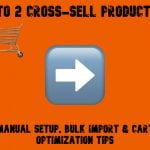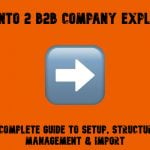The Ultimate Guide To Magento 2 Integration (API, IPAAS, ESB, ETL, automation, no-code, consultancy)
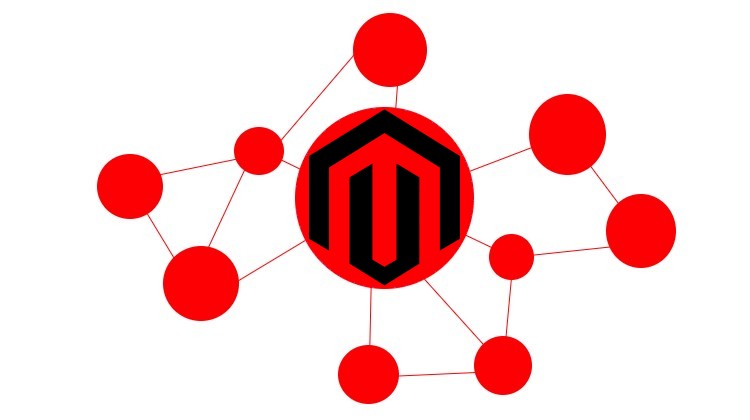
We explore the Magento ecosystem for almost a decade. In our blog, you can find lots of Magento 2 extensions reviewed. And there is a decent amount of integration modules among them, along with our flagship extension – Improved Import & Export for Magento 2. However, Magento 2 extensions introduce only a single way of system integration. In combination with native integrations, iPaaS systems, and custom solutions, they dramatically extend the default capabilities of Magento 2. In this article, you will learn what Magento 2 integrations are possible. We describe the four types mentioned above. After that, you will learn what Magento 2 integrationі are popular and how to establish them. We discuss Magento 2 integration with Slack, Microsoft Dynamics, ERPNext, Quickbooks, and Salesforce. But before going any further, let’s explain what Magento 2 is in case some readers are not familiar with the platform.

If you want to integrate any system with Magento 2 in the most effective way – write to us!
Table of contents
What is Magento 2?

Magento is an Adobe-owned platform that focuses on building e-commerce websites. Users of Magento have access to hundreds of special features that enable them to communicate with and sell their products to clients.
The first version of Magento was released in 2008, and it has been around since then. According to Datanyze, it currently holds a 3% market share in the ecommerce platform sector.
In order to address some of the issues with Magento 1 – the initial version, Magento announced the release of Magento 2 in 2015. Magento 1 users were urged to switch to Magento 2.
The end of June 2020 marked the formal end of official support for Magento 1. This indicates that Magento will no longer produce patches or updates for M1, so here are a few Magento 2 features that introduce advantages over the previous version:
- Website architecture is way more flexible and adaptable;
- New features deliver more engaging client interactions;
- With the updated admin, you can get more effective backoffice management;
- 50% quicker loading times than in Magento 1;
- More secure and user-friendly payments.
Thus, Magento 2 is a better version of Magento 1. At the same time, it is a completely new platform, which was dismantled and rebuilt by the developers in response to concerns and criticisms. So, Magento 2 is the way to go if you’re searching for a website that is quicker, safer, and more scalable. Below, you can see several features that make Magento 2 so popular among merchants:
- Progressive Web Apps (PWA). The Magento PWA Studio makes it easy to design your e-commerce store as a progressive web app with faster loading time, quick accessibility in poor network conditions, advanced responsiveness, etc.
- Drag-and-Drop Functions. The BlueFoot CMS integration in combination with Page Builder makes it easy for merchants to create and customize web pages even without any coding skills.
- Enhanced Payment Methods. Another system integration that is by default available in Magento 2 is related to its payment features. The platform is integrated with Klarna to enhance the shopping experience with instant checkouts, easy returns, and divided payments.
- Instant Purchase. Returning customers can benefit from instant purchases that reduce the time taken to checkout. This feature incorporates auto-filled fields that use information saved in the customer account.
- Advanced Admin Dashboard. Magento 2 is associated with an intuitive and feature-rich admin user interface where you can control all aspects of your online business: products, inventory, sales, orders, invoices, etc. If the default functionality is not enough, lots of third-party modules and system integrations are at your service.
- Two-Factor Authentication. With Magento 2, you also get dramatically improved security. The two-factor authentication is an inevitable part of the platform that exists apart from the login id and password.
In addition to these and numerous other features, it’s easy to keep expanding with Magento since the platform provides a selection of extensions and themes. Users can customize their websites as they wish, improving client experiences. Also, various integrations are available among them. Let’s see what opportunities are associated with Magento 2 integrations.
Magento 2 integrations
You can connect Magento 2 to the technologies you are already using to boost productivity, market your products more effectively, foster better customer collaboration, and much more. There is no need to leave the ecosystem because a sizable number of native and third-party Magento 2 integrations are available on the platform’s marketplace. At the same time, there are iPaaS and custom connectors if the extensions from the marketplace are not enough. Let’s see what ways to maintain Magento 2 integrations are available.
Native Magento 2 integrations
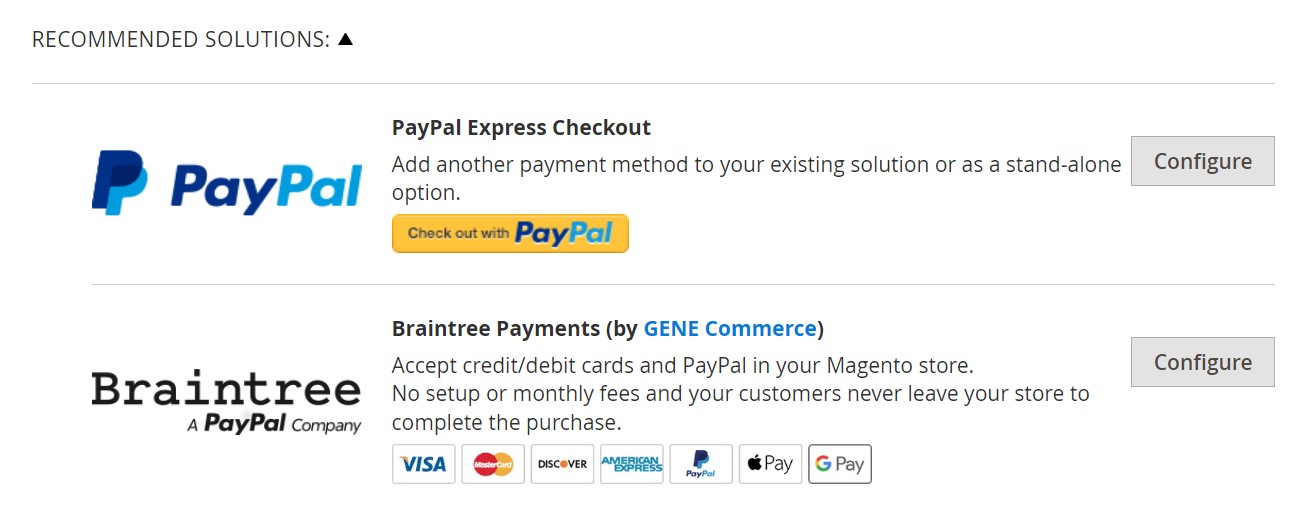
Since vendor-built integrations for Magento 2 may vary depending on your store version, let’s take a look at Magento Open Source 2.4.5 to illustrate how Adobe implements native integration.
For instance, Magento 2 is tightly connected with Google Analytics. In 2.4.5 Adobe added the integration with GTag. This integration of Google functionality into website pages provides better tracking and content management through Google Services. Adobe Commerce, in its turn, incorporates a set of built-in modules, such as Google AdWords, Analytics, Optimizer, and TagManager. They leverage the former API for integration with Google services.
You don’t even need to install additional software, since everything is already included. Often, native Magento 2 integrations are configured and activated. They are built into your website so neatly that you don’t even consider the corresponding functionality integrated from an external system. Perhaps, payment and shipping providers are the best examples of tight collaboration. Apple Pay, PayPal, Braintree, UPS, DHL, FedEx, and numerous other external systems are always at the service of your clients when they visit your Magento 2 website.
If the default integrations are not enough, you can always use third-party modules to enhance the basic functionality of your e-commerce website.
Third-party Magento 2 integrations
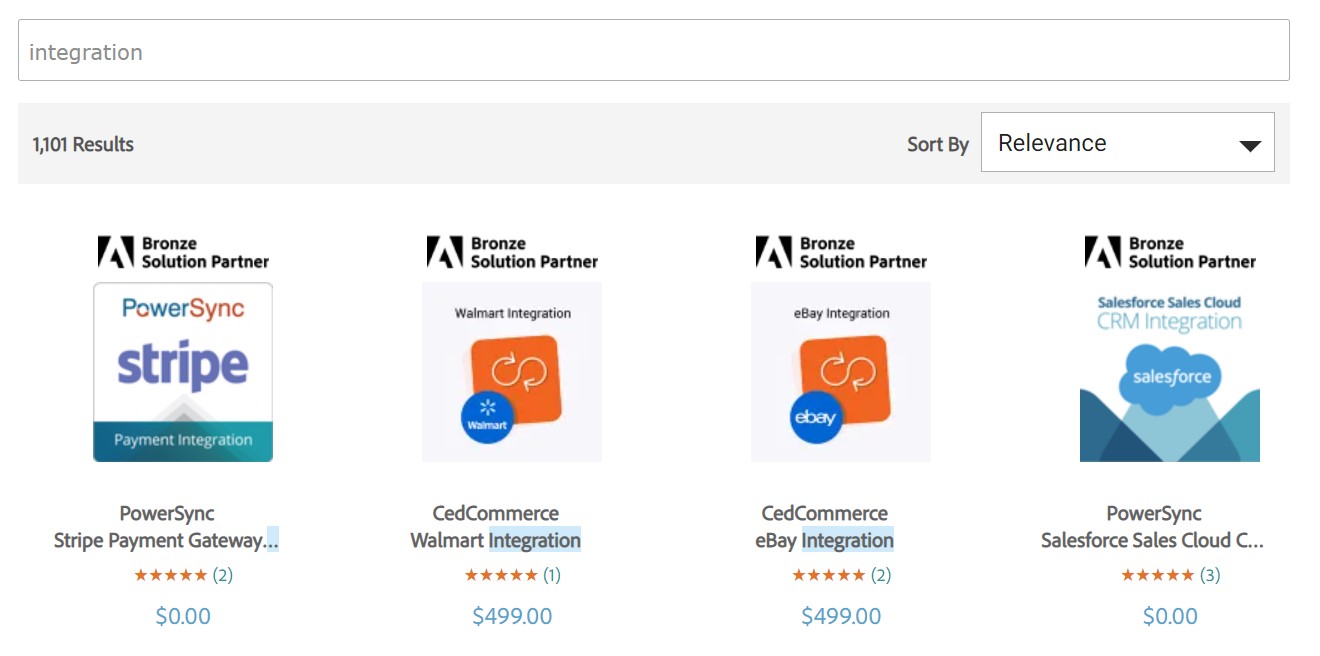
There are more than 3,000 extensions available on the Magento Marketplace. Of course, not all of them are intended to create Magento 2 integrations. When you search for “integration,” more than 1,000 results are displayed. Two groups of integrators are available: universal connectors and modules designed for a particular integration only.
When it comes to modules developed for specific Magento 2 integrations, you can take a look at the following tools as good examples:
- ;
- ;
- ;
- .
However, if you don’t want to create too many silos, turning your e-commerce website and the connected systems into a “spaghetti” mess, you need a universal connector. In the realm of third-party modules, pay attention to our Improved Import & Export extension for Magento 2. It is the most powerful solution for data transfers. The extension can be fully managed from the administrator panel without the need for any technical expertise. You can import and export practically every Magento 2 and Adobe Commerce/Cloud entity. The module lets you import and export information about customers, categories, products, orders, CMS pages, cart price rules, etc.
Since Improved Import & Export covers most entities Magento 2 incorporates, you can use the plugin for Magento 2 integrations with CRM and ERP systems, accounting solutions, and other e-commerce platforms. Follow the link below to discover more information about the extension:
Get Improved Import & Export Magento 2 Module
iPaaS Magento 2 integration solutions
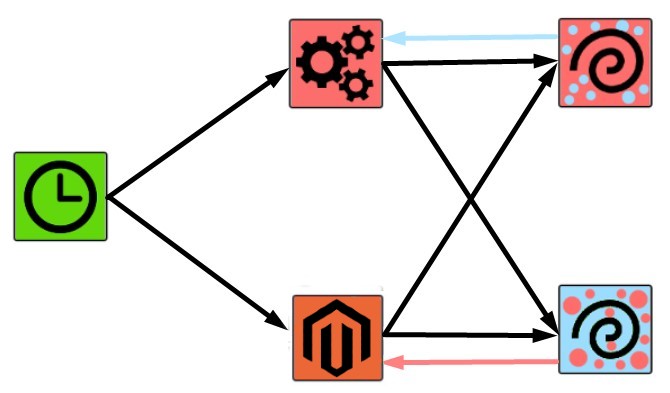
If you are looking for a tool that is even more powerful and flexible than our extension, pay attention to iPaaS platforms. Compared to native and external ERPNext connectors, iPaaS solutions offer a much wider range of configurable connectivity choices. Instead of synchronizing your e-commerce store with a few external platforms, they support hundreds of integrations.
The simplicity with which you can design effective Magento 2 integrations and manage complex activities is a further important benefit. iPaaS platforms are built around drag-and-drop capabilities and preconfigured templates.
Native connectors, in turn, demand much work. In some cases, they help you integrate two systems partially, so you still need to maintain the remaining data exchanges manually. However, iPaaS systems help you avoid such headaches.
As a result, you can make Magento 2 integrations with dozens or even hundreds of other platforms very quickly. Furthermore, the typical iPaaS functionality can be altered because the majority of connections adhere to the “code when necessary” principle.
Below, you can see the core iPaaS advantages over native and third-party connectors:
- The user interface is simple. A visual workflow editor, drag-and-drop flexibility, copy + paste operations, and import/export capabilities are all included in the iPaaS-powered Magento 2 integrations.
- Process automation at work. You can use conditional logic, webhook triggers, and workflows with multiple triggers to initiate data transfers automatically when specific events take place in one of the connected systems.
- Outstanding error handling. In iPaaS-based Magento 2 integrations, manual error management is avoided because the connector restarts data exchange if execution is unsuccessful.
- Advanced customization. Custom Magento 2 integrations within iPaaS are doable due to the downloadable source code and “code when necessary” principle.
- Fantastic security. iPaaS integrations are safe since sensitive data is kept locally and passwords are protected.
When you need to create Magento 2 integrations based on iPaaS, the following entities and actions are usually at your service:
| Entity | Description | Supported actions |
| Customer | A customer is someone who purchases goods and services on your Magento 2 website. |
|
| Invoice | An invoice is a document that represents an agreement between your store and a customer and contains order details. |
|
| Order | An order is a collection of goods or services that a consumer adds to their shopping cart and pays for on the checkout page. |
|
| Product | A product is a physical or digital item or service sold on your Magento website. |
|
For instance, you can automatically create a new customer on your Magento 2 website when somebody purchases from you on Amazon. The corresponding workflow discovers new buyers associated with your store on Amazon and passes this information to Magento 2. Furthermore, you can also add a CRM system to this integration. As a result, all three points will get the same unified information about your customers.
Custom Magento 2 connectors
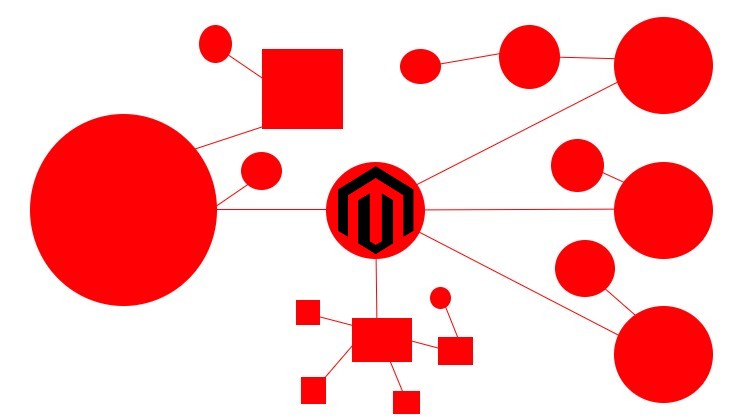
If iPaaS systems are not flexible enough to satisfy your specific business demands, you need to pay attention to custom Magento 2 connectors. We provide custom development and data management services for Magento 2 and Adobe Commerce projects of any complexity. Building competitive solutions and enduring relationships with our clients is something we are focused on.
The Firebear team operates in the following areas:
- Integration with ERP systems such as SAP B1 and MS Dynamics;
- Integration with Product Information Management software;
- Integration with CRM systems;
- Integration with accounting software, middleware, files, and webhooks;
- One-side or bi-directional real-time sync for Magento 2 and Adobe projects..
Contact us for more information.
Most Popular Magento 2 Integrations
The most popular Magento 2 integrations include:
- Magento 2 Slack Integration
- Magento 2 Microsoft Dynamics 365 Integration
- Magento 2 Erpnext Integration
- Magento 2 Quickbooks Integration
- Magento 2 Salesforce Integration
Magento 2 Slack Integration
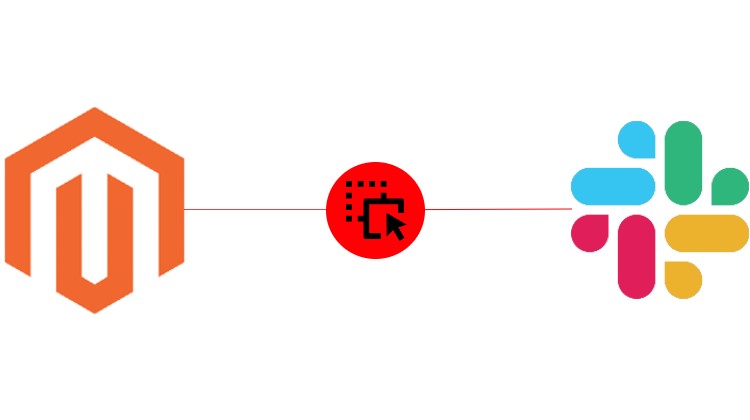
Many businesses throughout the world have access to the Magento 2 Slack integration thanks to iPaaS platforms. Your regular tasks might be made even simpler by using an instant messaging program linked to your e-commerce website. Slack, which was created for business and organizational communications, has become popular as a community platform and includes a ton of capabilities for all types of companies. For instance, it groups talks into channels so that participants may convene in a single location to exchange ideas and make choices, speeding up the workflow. As a result, teams work more quickly and efficiently. But given how powerful Slack is currently, why is it necessary to use the Magento 2 Slack integration?
The Magento 2 Slack connection can enhance team communication even further. Even though Slack is a chat platform, it links your employees to the information they need by bringing them together to work as one cohesive team. It combines the following organizations on the Slack side:
- Channel – a channel is a space where your conversations are clearly organized per project, topic, or team.
- Message – a message is a piece of information in any form posted to a conversation.
- File – a file is complex data above and beyond text: spreadsheet, PDF, error log, document, image, etc.
- Reaction – a reaction is an emoji posted as a reply to a message.
- Star – a star is a symbol that lets you mark a channel or direct message to keep track of important conversations.
- User – A user is a Slack workspace user.
- User Group – A user group is a group of people simultaneously notified in a workspace.
The Magento 2 Slack integration is a great way to keep your employees up-to-date on your team’s activities. The integration is especially useful because your managers stay informed even if they don’t have access to certain areas of your Magento admin. For instance, your administrator doesn’t have access to the Order section of your store. However, you can inform them every time a new order is placed via Slack The corresponding workflow looks as follows:
- You create a cron node that launches the workflow regularly (once in 5 minutes), initiating a search process (1) that discovers new orders on your Magento website (2).
- Next, the search node passes order data to another node (3) that launches a notification in Slack (4), informing your admin about new orders.
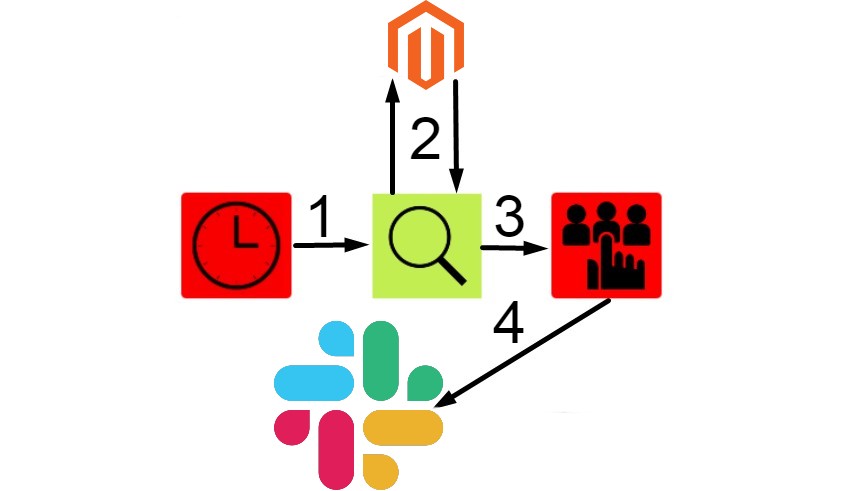
You can create as many workflows like this one as you need, including other entities in the process. Contact us to learn more about the Magento 2 Slack integration. Note that there are neither third-party modules nor native connectors that provide the ability to create this integration.
Magento 2 Microsoft Dynamics 365 Integration
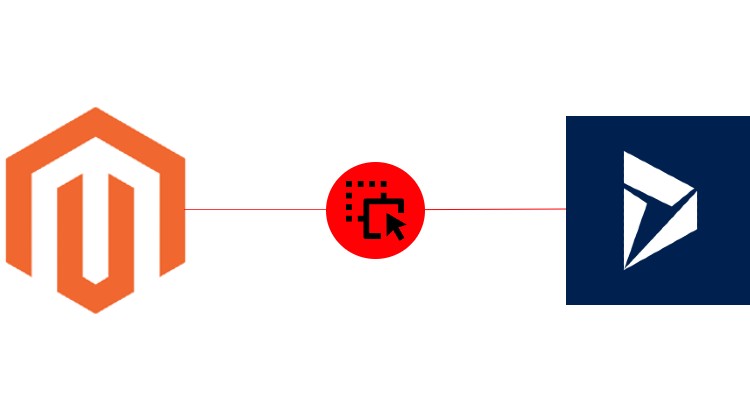
Enterprise resource planning and customer relationship management technologies are both parts of the Microsoft Dynamics business application suite. Microsoft Dynamics concentrates on the manufacturing, financial services, retail, services, and government sectors.
Due to the support of a wide range of market segments, businesses of all sizes can leverage specific solutions from the Microsoft Dynamics family that focuses its marketing and innovation efforts on SaaS and the following products:
- Microsoft Dynamics 365 for Finance and Operations – The ERP and CRM software-as-a-service package for mid-sized and big businesses.
- Microsoft Dynamics 365 Business Central – Another ERP and CRM software-as-a-service product for small and mid-sized companies.
- Microsoft Dynamics 365 Customer Engagement – A CRM system for businesses of all sizes.
iPaaS-based Microsoft Dynamics integrations incorporate the following CRM entities:
- Lead – Leads are used to keep track of business prospects who have not yet been qualified through your sales process.
- Contact – A contact is someone with whom a business unit has a relationship, such as a customer, a supplier, or a coworker.
- Account – A company with which the business unit has a relationship is represented by an account. Contact information, company information, category, relationship type, and address information are all part of the account information.
- Opportunity – Use opportunities to represent a potential deal to new or existing consumers.
- Incident (Case) – Track a customer request, inquiry, or problem using incidents, also known as cases.
You can not only create your Magento 2 Microsoft Dynamics 365 integration with the help of iPaaS but also automate it. For instance, you need to create a new account on the MS Dynamics side every time a new company account is registered on your Magento 2 website. The corresponding workflow should look as follows:
- A cron node initiates a search process (1) that discovers new company accounts registered on your Magento website (note that it is a B2B feature, so you either need to use Adobe Commerce or special third-party modules on your e-commerce website).
- Next, use a filter node that checks whether these company accounts are new to MS Dynamics 365 (3).
- After that, the filter node provides (4) newly discovered information to a generation node that creates accounts on the MS Dynamics side (5).

You can create as many workflows like this one as you need, including all B2B or standard entities. Contact us to learn more about the Magento 2 Microsoft Dynamics 365 integration. Note that this integration is not available in native connections. As for third-party modules, you can find tools like Commercient SYNC For Microsoft Dynamics AX still available on the marketplace despite AX being replaced with 365. МAnd tools like i95Dev Dynamics 365 Finance & Operations Connect have zero reviews.
Magento 2 ERPNext Integration

ERPNext is a fully-featured ERP system that offers numerous solutions for retail, education, healthcare, agriculture, etc. Its tools are suitable for manufacturers, distributors, and service companies. You can leverage various modules for accounting, CRM, sales, purchasing, etc. Its core tools are used in the following areas: financial accounting, order management, payroll, human resources, manufacturing, CRM, project management, helpdesk, asset management, content management, etc.
As for the Magento 2 ERPNext integration, the following objects are involved:
- Customer – A customer is your buyer.
- Invoice – An invoice is an agreement between a store and a person that includes all order detail.
- Order – An order is a collection of goods or services checked out on your Magento website.
- Product – A product is a physical or digital item or service available in your catalog on your Magento website.
You can automate your Magento 2 ERPNext integration with the help of iPaaS. For instance, you need to create a new product record in ERPNext every time a new product is added to your Magento 2 database. The corresponding workflow consists of the following steps:
- A cron node first initiates a search process (1) that discovers new products on your Magento website.
- Next, a filter node checks whether these products are new to ERPNext (3).
- After that, the filter node provides (4) newly discovered products to a generation node that creates new product records on the ERPNext side (5).
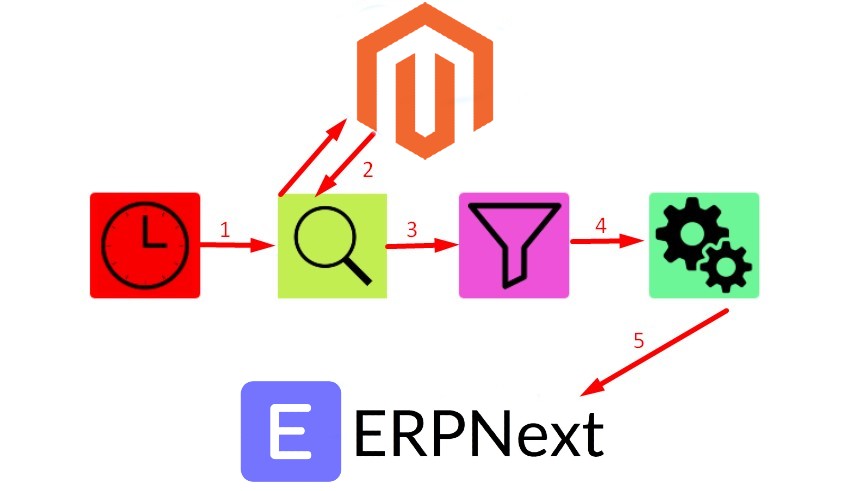
You can use a similar workflow that also inspects product price and quantity changes. When new information is discovered, it forms an update and transfers if to ERPNext. Contact us to learn more about the ERPNext Magento 2 integration. Note that there are neither third-party modules nor native connectors that provide the ability to create this integration.
Magento 2 Quickbooks Integration
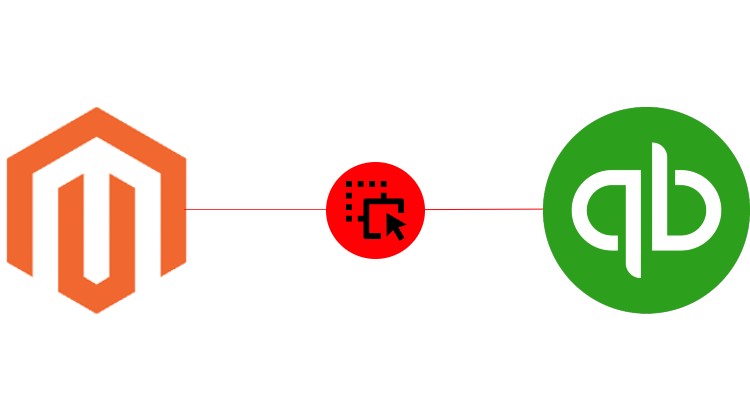
QuickBooks is an accounting software program created by Intuit that offers solutions for managing money, taxes, and personal. It can assist organizations in automating tasks such as invoicing, payments, accounting, and more. These capabilities make it easier to manage and track the firm’s finances.
QuickBooks Online is compatible with other Intuit products, including TurboTax and ProConnect. You can also use iPaaS systems to run integrations with external tools. The Magento 2 Quickbooks integration allows you to add the following elements to your automated workflow:
- Bill – A bill is an object that is used to describe a transaction that is owed to a vendor. In other words, it is an invoice that your vendors send to you in order to collect money from you.
- Customer – A customer is someone who pays for your products and services.
- Employee – An employee is a person who works for the company.
- Estimate – An estimate is a quote for goods or services given to a customer. If the customer approves the quote, it can be converted into a sales order or invoice.
- Invoice – An invoice is a document that is used to record sales transactions from consumers that make no or partial payments. Invoices aid in the management of your accounts receivable.
- Item – An item is a product or service a firm buys and sells.
- Payment – A payment object is used in QuickBooks to record a payment. It can be applied to many Invoices and Credit Memos for a single customer.
- Purchase – A purchase object reflects an expense you incur, such as a vendor purchase. A buy order informs vendors of your intention to purchase.
- Transaction – A transaction type describes the sort of transaction that occurred, such as a client transaction, a bill payment, or a bank transfer.
- Vendor – A vendor is a person or company who sells you things or provides you with services.
Your Magento 2 Quickbooks integration may look as follows. Assume you need to update customer’s details in Quickbooks every time the corresponding customer data is changed in Magento 2. The corresponding workflow consists of just a few elements::
- A cron node initiates a search process (1) that looks for Magento 2 customers (2).
- The search node provides (3) newly discovered information to another node that analyzes it and filters out customers that have been updated towards the Quickbooks records.
- The next node receives the information (4) necessary for updating customer information on the Quickbooks side (5).

And it is the only example of how the automated Magento 2 Quickbooks integration can improve your daily duties. Contact us to learn more. You can also try or to establish this integration. Both developers are Bronze Solution Partners.
Magento 2 Salesforce Integration
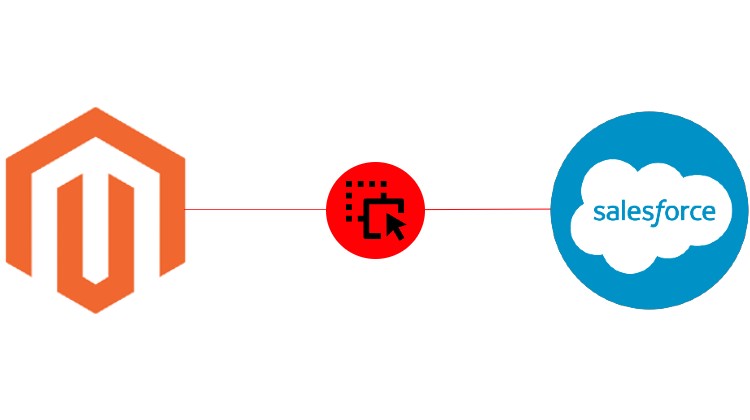
Salesforce is a cloud-based CRM software supplier that helps businesses all over the globe grow their customer base, increase sales, and improve customer care. Its solutions include support, sales, and marketing tools that employ cloud technology to communicate with partners, customers, and potential clients, track their activity, and create excellent customer experiences.
Another notable benefit of Salesforce is automation. You can utilize the system to perform a variety of common operations without the need for manual interaction. The following entities are at your service:
- Lead – A lead is a potential customer who is interested in your products and services. With a large network of contacts, you can convert leads into opportunities, contacts, or accounts (deals pending).
- Contact – A contact is a lead that has been identified as a possible customer.
- Account – An account is a current customer that meets the company’s qualifications or business that is a potential partner.
- Opportunity – An opportunity is a current deal that states whose accounts it is for, who the player is, and how much potential revenue there is.
- Case – A case is a question, comment, or issue your support agent got from a client.
- Attachment – An attachment is a document attached to a record.
- Document – A document is a user-uploaded file.
You can streamline these entities to automate your Magento 2 Salesforce integration. Suppose you need to create a new contact in Salesforce when a new customer is registered on your e-commerce website. Consider the following workflow:
- A cron node begins a search process (1) that locates new Magento 2 customers (2).
- A filter node checks whether these customers are unique to Salesforce(3).
- The filter node supplies (4) newly discovered clients to a generation node that creates new contacts in Salesforce (5).
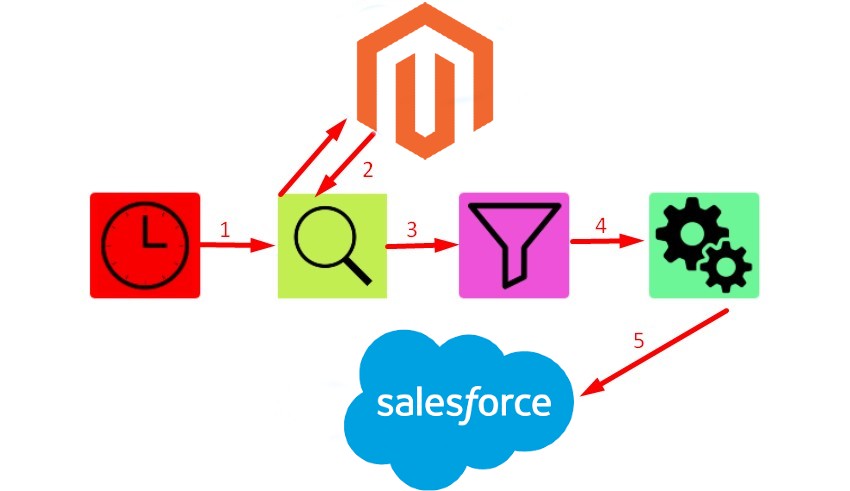
You can create a workflow that does absolutely the same thing but in the opposite direction. Contact us to learn more opportunities associated with the Magento 2 Salesforce integration.
and are two examples of Magento 2 Salesforce integration with the help of third-party extensions. Both vendors are Bronze Solution Partners.
Conclusion
Although the Magento 2 ecosystem has more than 3,000 third-party extensions, they are not always enough to create all Magento 2 integrations that your business may require. Therefore, iPaaS systems gain popularity. They not only introduce integrations that are not available on the Magento marketplace but also simplify data synchronization with the help of a drag-and-drop interface and predefined workflows. Another good thing is that you need only one iPaaS platform to cover most of your integration demands, while the use of third-party extensions for Magento 2 integrations is associated with numerous modules. And of course, custom integrations are always at your service. Just find a reliable partner and order a tool that satisfies your business demands 100%.
If you want to integrate any system with Magento 2 in the most effective way – write to us!
Magento 2 Integration FAQ
What are Magento integrations?
Under Magento 2 integration we assume a process of connecting your e-commerce website to other systems and platforms. Therefore, Magento 2 integrations are these connections. You deal with native integrations, like PayPal or FedEx, by default straight in your admin.
At the same time, a bunch of third-party integrations are available on the Magento marketplace. Just find a connector for the desired system and install it on your e-commerce website.
Also, you can leverage iPaaS systems to create workflows that maintain Magento 2 integrations with hundreds of external systems.
And custom connectors are at your service. An integration enables third-party services to call the Magento web APIs in the following areas: accounting, ERP, CRM, PIM, marketing automation, etc.
What is Magento API?
Magento API is a framework that empowers external systems with the ability to connect to Magneto to sync data and perform various actions. Magento works with SOAP and REST APIs.
What are examples of Magento 2 integrations?
Built-in PayPal integration, Salesforce connectors, and Data sync between Magento 2 and Quickbooks based on the Zapier iPaaS are examples of Magento 2 integrations.
How to create an integration in Magento?
Follow these steps to create an integration in Magento 2 manually:
– Visit Admin->System->Integrations.
– Click Add New Integration.
– Specify the integration name and other parameters..
– Grant access to the API resources.
– Save the configuration and check the result.
What are four ways to create Magento 2 integrations?
You can leverage four different approaches while working with Magento 2 integrations. First of all, it is native integrations that are already available in your admin. Secondly, it is third-party integrations from the marketplace. Thirdly, you can use iPaaS systems to create Magento 2 integrations. Fourthly, it is possible to create custom connectors that follow your specific integration demands.








